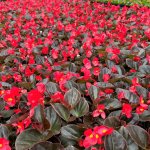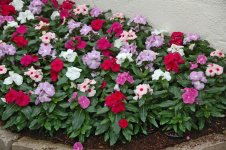
April is here! Time to get our garden on!
For the past two months, I have warned my readers against planting spring flowers too early. I’ve warned against applying lawn fertilizer too early. March indeed did feel like a Spring month this year. Normally, Old Man Winter will have a final say in late March so there lies the risk.
Historically speaking, in North Texas we typically see our last freeze by April 1 each year.
Well, April is here and there are no more restraints to hold us back. So LETS GARDEN!!
A lot of gardeners will start their spring planting off with spring annual flowers. The term “annual” means we replace them each season. These are the flowers that have “pop” and grab the attention of passers by. Below, I will break down what works, what doesn’t, and how to know what to get for any given side of your home.

Red Begonias, above
Full Sun Locations
For full sun environments, there are basically three types of flowers that will perform from Spring to Fall. They are best when planted close together for maximum visual impact. You can choose to stay with one or two colors – or – go with a mixed color display instead.
As a general rule, flowering plants bloom more blooms in sunny locations. The sunlight makes them bloom. So these locations are great opportunities to create a colorful display.

Pentas – Pentas (shown above) are big sun lovers and can take the heat we get in North Texas. They bloom in red and white clusters. Like most annuals, they don’t get very tall.
Begonias – Begonias (shown above) feature smaller flowers but they are prolific in their blooming. A sea of red Begonias surrounding a white or yellow Hibiscus looks outstanding. Begonias come in white, pink and red bloom colors. Most varieties desire full sun, but there is a variety that can be used in shaded environs.

Periwinkles (Vinca) – Another prolific bloomer that performs throughout the season. These are really special when you use mixed colors. Periwinkles can have lavender, dark and light pink, white and red blooms. These babies can grow to 15 inches or taller by end of summer.
If you have a large space to fill and a limited budget, try using green and purple Potato Vine.
Center features
Normally, we like to have a larger plant in the middle or at the back of our flower display. This gives a variance in height and creates interest. Tropical Hibiscus is a great choice as is Purple Fountain Grass and in some cases Esperanza. Wave Petunias can be very impressive as well, but they do get expansive. Wave Petunias make a great choice for hanging baskets, too.
Flowers that will not make it through the season . . .
Let’s be honest, Petunias are one of the most beautiful flowers going. Their rich, bold colors and large blooms are striking and attention-grabbing. However, they will begin declining as temperatures get into the upper 90s and 100s. In Texas, that can start in May. So if you’re looking for a temporary display or a quick dose of color, Petunias are a great choice.
Impatiens are a beautiful flower, but they can be very finicky with their care. They love water, but do not like to stay wet. So when you plant them, make sure you use a nice, fluffy planting mix and keep them elevated slightly above the surrounding ground.
Full Sun Perennial Flowers
When you aren’t looking for quite as impressive floral displays and would love to not plant new flowers each year, you should consider using perennial flowers. Here are a few of my favorites:
1. Lantana – There are several varieties of Lantana that feature reds, oranges, whites, yellows and gold. Lantana Gold is probably the most common Lantana is our region. They grow large and bloom profusely. They are valued in our landscapes because they thrive in high heat and full sun and don’t require as much water as other flowering plants.
2. Cat Mint – One of the hardest plants to find are ones that feature blue flowers. Cat Mint is one of those which can give you the blue you love and loves our Texas summers. These are very faithful about coming back each season after winter dormancy.
3. Homestead Verbena – Sprawling plant that grows low to the ground and features large clusters of deep purple flowers. Excellent when mixed with white or yellow flowering plants.
4. Stella De Oro Daylilies – These are very lush looking plants and are faithful bloomers, blooming off and on from February through November. They are deceptively tough and can take our hottest summers without skipping a beat. Additionally, the harder our winters are, the more robust they return each spring.

Coleus, above.
Shaded Locations
One thing we must remember when it comes to planting in heavily shaded areas is that the flowers you see above will not work in these spaces. Sun causes blooming these areas get limited or filtered sunshine. We must rely on shade-loving plants with colorful foliage in order to achieve our color.
Try pairing up combinations of plants that set each other off. For example, use colorful Coleus (purples, pinks, lime green), mixed with Persian Shield (deep, shiny purple foliage), Foxtail Fern (light green), Oxalis (burgundy), Lemon Coral Sedum (neon yellow), Cordyline (burgundy) and Crotons (multiple colors, red, yellow, orange and green).
Persian Shield and Crotons can also be grown in east-facing locations that are protected against the afternoon sun.
Bed Preparation
Take the time to break up the soil before you plant your flowers. Break up the soil and add and mix fresh, new planting mix that is both airy and fertile. Your flowers should be planted slightly elevated above surrounding areas of the bed to insure proper drainage. Flowers like water, but they like to dry out between waterings. They will not perform if they stay wet.
Wait a few weeks after planting to apply a mild flower food product to your plantings. Once we are in the 90s, do not fertilize your flowers.
Time to Fertilize!
With the arrival of April, we are now at liberty to fertilize our lawns which have been emerging from winter dormancy. There is no point in fertilizing any earlier than April as our turf is not actively growing in March. But with the warmth of April and the rainfalls that come with it, our turf grows as a pretty fast clip this month.
The first thing we need to consider when fertilizing our lawns is what type of turf you have. In North Texas, odds are you either have Bermuda, St Augustine or some type of Zoysia. You must not treat them the same as they have very different requirements.
Bermuda fertilizers are extremely high in nitrogen, normally a 27-36 percent nitrogen is what Bermuda prefers. However, if you were to put that same fertilizer on a St Augustine or Zoysia lawn, you would burn it up. If you have a St Augustine or Zoysia lawn, you must use fertilizer products made specifically for that. Ones that feature a Nitrogen level of 15 to 19 (milder).
Scott’s Turfbuilder® is a great fertilizer for Bermuda Lawns. Scott’s Bonus S® is geared toward St Augustine and Zoysia. Fertilome makes a great St Augustine weed and feed that is also used on Zoysia.
The products listed above are “weed and feed” products, meaning they also have a weed killing ingredient. This is another reason why it is important to use specific products. Weed killers used in Bermuda weed/feed products will damage or kill St Augustine or Zoysia turf. Likewise, Bermuda does not like the weed killing ingredient used in St Augustine weed/feed products. So know what you have and what to get, before you go purchase.
On the back of your bag of fertilizer, many products (such as Scott’s) will show a chart where a number of spreader products are listed and the associated spreader setting to be used for the fertilizer in the bag. Go by this recommended setting. You DO NOT want to over apply fertilizer. This is clearly a situation where more is not better. When done according to the setting, you get predictably good results.
Water immediately after applying your fertilizer. Water again the next day. This is to get the product into the soil where your grass can use it.


